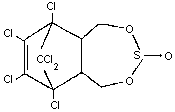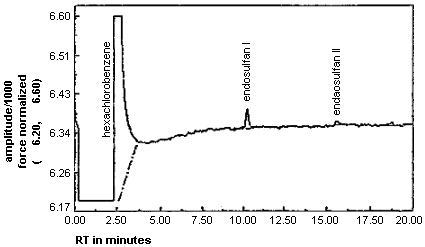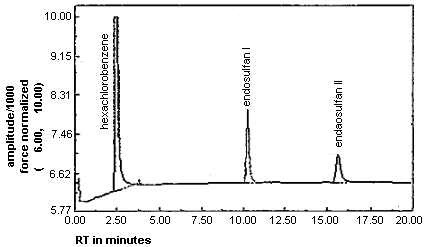ENDOSULFAN
| Method number: | PV2023 |
| Matrix: | Air |
| Target Concentration: | 0.1 mg/m3 (TLV time weighted average) |
| Procedure: | Samples are collected by drawing known volumes of air through
OSHA versatile sampler tubes (OVS-2) containing a glass fiber filter
and two sections of |
| Recommended air volume and sampling rate: |
60 L at 1.0 L/min |
| Detection limit of the overall procedure (based on the recommended air volume): | 3.4 µg/m3 |
| Status of method: | Stopgap method. This method has been only partially evaluated and is presented for information and trial use. |
| Date: April, 1988 (final) | Chemist: Duane Lee |
Carcinogen And Pesticide Branch
OSHA Analytical
Laboratory
Salt Lake City, Utah
1. General Discussion
1.1. Background
1.1.1. History of procedure
The OSHA Analytical Laboratory received a set of samples
requesting the analysis of endosulfan from glass fiber filters.
Retention and storage studies on glass fiber filters yielded poor
recoveries of endosulfan. Therefore, this report describes the
preliminary validation of a sampling and analytical method using
1.1.2. Toxic effects (This section is for information only and should not be taken as the basis of OSHA policy).
Technical endosulfan consists of about four parts of
There are reports of workers becoming ill from inhalation of dust from endosulfan. Symptoms of slight nausea, confusion, excitement, flushing and dry mouth were experienced (Ref. 5.3.). Also, endosulfan is a central nervous system stimulant for which no specific antidote is available (Ref. 5.1.).
Accordingly, a TLV of 0.1 mg/m3, as a
1.1.3. Potential workplace exposure
No estimate of worker exposure to endosulfan could be found. Endosulfan is a broad spectrum insecticide for control of vegetable, fruit, field crop, and ornamental pests (Ref. 5.1.).
1.1.4. Physical properties (Ref. 5.1. and 5.3.)
| Molecular weight: | 406.95 |
| Molecular formula: | C9H6CL6O3S |
| CAS #: | 115-29-7 |
| Specific gravity: | 1.735 at 20 °C |
| Melting point: | 70-100 °C |
| Solubility: | Insoluble in water; soluble in xylene, kerosene, chloroform, acetone, and alcohol; decomposes in the presence of acids and alkalies to form sulfur dioxide. |
| Chemical name: | 6,7,8,9,10,10-hexachloro- |
| Synonyms: | Thiodan, Benzoepin, Cyclodan, Beosit, Endocel, Chlorthiepin, Crisulfan, Endosan, Endosol,Hildan, Insectophene, Malix, Thifor, Thimul, Thiofor, Thionex, Tiovel |
| Structure: |  |
| Description: | Technical endosulfan is a tan,
|
1.2. Limit defining parameters
The detection limit of the analytical procedure is 13.5 pg per injection. This is the amount of analyte which will give a peak whose height is approximately five times the baseline noise. (Figure 1)
2. Sampling procedure
2.1. Apparatus
2.1.1. Samples are collected by using a personal sampling pump that can be calibrated to within ±5% of the recommended flow rate with the sampling device in line.
2.1.2. Samples are collected with
2.2. Reagents
None
2.3. Sampling technique
2.3.1. Attach the small end of the sampling tube to the sampling pump with flexible plastic tubing such that the large front section of the sampling tube is exposed directly to the atmosphere.
2.3.2. Attach the sampler vertically in the employee's breathing zone in such a manner that it does not impede work performance.
2.3.3. After sampling for the appropriate time, remove the sampling device and seal the tube with plastic end caps.
2.3.4. Wrap each sample
2.3.5. Submit at least one blank for each set of samples. Handle the blank in the same manner as the samples, except no air is drawn through it.
2.3.6. Record the air volume (in liters of air) for each sample, and list any possible interferences.
2.3.7. Submit bulk samples for analysis in a separate container.
2.4. Desorption efficiency
Six
Table 2.4.
Extraction Efficiency
| Amount | Amount | % | |
| Sample # | Spiked, µg | Found, µg | Recovered |
| Ex1 Ex2 Ex3 Ex4 Ex5 Ex6 |
6.33 6.33 6.33 6.33 6.33 6.33 |
5.40 5.19 5.47 5.16 5.30 5.36 |
85.3 82.0 86.4 81.5 83.7 84.7 |
| Average = 83.9 | |||
2.5. Retention efficiency
Five
Table 2.5.
Retention Efficiency
| Amount | Amount | % | |
| Sample # | Spiked, µg | Found, µg | Recovered |
| R1 R2 R3 R4 R5 |
6.33 6.33 6.33 6.33 6.33 |
5.68 5.85 5.65 5.59 5.36 |
89.7 92.4 89.3 88.3 84.7 |
| Average = 88.9 | |||
2.6. Sample storage
Twelve tubes were liquid spiked with 15 µL of a 422 µg/mL standard and humid air (~80% relative humidity) was drawn through each tube at 1 L/min for 60 minutes. Six of the samples were stored at ambient temperature in a drawer, and six were stored in a refrigerator. After four days of storage, three samples from each group were desorbed with 3 mL of toluene by shaking for 60 min and then analyzed. The remaining samples were desorbed and analyzed after seven days of storage. The results are given in the tables below.
Table 2.6.1.
Ambient Storage
| Amount | Amount | % | |
| Sample # | Spiked, µg | Found, µg | Recovered |
| 4 4 4 7 7 7 |
6.33 6.33 6.33 6.33 6.33 6.33 |
6.08 5.72 5.77 5.99 5.74 5.41 |
96.0 90.4 91.2 94.6 90.7 85.5 |
| Average of 4 days = 92.5 | |||
| Average of 7 days = 90.3 | |||
Table 2.6.2
Refrigerated Storage
| Amount | Amount | % | |
| Sample # | Spiked, µg | Found, µg | Recovered |
| 4 4 4 7 7 7 |
6.33 6.33 6.33 6.33 6.33 6.33 |
6.08 5.85 5.48 5.67 5.77 5.69 |
96.0 92.4 86.8 89.6 91.2 89.9 |
| Average of 4 days = 91.7 | |||
| Average of 7 days = 90.2 | |||
2.7. Recommended air volume and sampling rate
2.7.1. The recommended air volume is 60 L.
2.7.2. The recommended flow rate is 1.0 L/min.
2.8. Interferences
It is not known if any compounds will interfere with the collection of endosulfan.
2.9. Safety precautions
2.9.1. Attach the sampling equipment in such a manner that it will not interfere with work performance or employee safety.
2.9.2. Follow all safety practices that apply to the work area being sampled.
3. Analytical procedure
3.1. Apparatus
3.1.1. A balance capable of weighing to the nearest tenth of a milligram. A Mettler HL52 balance was used in this evaluation.
3.1.2. Mechanical rotator.
3.1.3. A gas chromatograph (GC) equipped with an electron capture detector (ECD). A Hewlett Packard 5890 was used in this evaluation.
3.1.4. A GC column capable of separating endosulfan from any
interferences. A 10 m × .32 mm i.d. (1.0 µm film)
3.1.5. An electronic integrator, or some other suitable method
for measuring detector response. The
3.1.6. Volumetric flasks and pipets.
3.1.7. Vials,
3.1.8. Vials,
3.2. Reagents
3.2.1. Toluene high purity Burdick and Jackson.
3.2.2. Endosulfan EPA 3180 97.6% purity.
3.2.3. Hexachlorobenzene, reagent grade.
3.2.4. Desorbing solvent, hexachlorobenzene (2µg/mL) in toluene
3.3. Standard preparation
Prepare stock standards by weighing 10 to 14 mg of endosulfan,
placing in
3.4. Sample preparation
3.4.1. Transfer the glass fiber filter and large section of the
adsorbent of each sample to a
3.4.2. Pipet 3.0 mL of desorbing solvent into each vial and seal
with a
3.4.3. Rotate the vials for 60 minutes.
3.5. Analysis
3.5.1. Instrument conditions
| Column: | DB-5, 1.0 µm film, 10 m × 0.32 mm i.d. |
| Injector temperature: | 235 °C |
| Column temperature: | 170 °C |
| Detector temperature: | 300 °C |
| Gas flows: | Column 8.6 mL/min hydrogen Make up 42 mL/min nitrogen |
| Injector volume: | 1.0 µL |
| Split ratio: | 5:1 |
| Retention time: | 10.3 min endosulfan I 15.6 min endosulfan II |
3.5.2. Chromatogram (see Figure 2)
3.6. Interferences
3.6.1. Any collected compound having a similar retention time and responds to an ECD is an interference.
3.6.2. GC conditions may be varied to circumvent an interference.
3.6.3. Retention time alone is not proof of chemical identity. Analysis by an alternate GC column and confirmation by mass spectrometry are additional means of identification.
3.7. Calculations
3.7.1. A calibration curve (figure 3) is constructed by plotting detector response versus standard concentration. The detector response is the value calculated from an internal standard method that sums the areas of the endosulfan I and endosulfan II peaks.
3.7.2. The concentration of endosulfan in a sample is determined from the calibration curve.
3.7.3. The air concentration is then determined by the following formula.
| mg/m3 = | (µg/mL in sample) × (extraction
volume in mL)
(air volume in liters) × (desorption efficiency) |
3.8. Safety precautions
3.8.1. Avoid skin contact and air exposure to endosulfan.
3.8.2. Avoid skin contact with all solvents.
3.8.3. Wear safety glasses at all times.
4. Recommendations for further study
The method should be fully validated.

Figure 1
Chromatogram at the Detection Limit

Figure 2
Chromatogram of Endosulfan

Figure 3
Calibration Curve
5. References
5.1. Farm Chemicals Handbook; Meister Publishing: Willoughly, Ohio, 1986, p C97.
5.2. Kirk-Othmer Encyclopedia of Chemical Technology; John
Wiley & Sons: New York, 1981, Volume 13, PP
5.3. Documentation of Threshold Limit Values and Biological Exposure Indices; American Conference of Governmental Industrial Hygienists Inc., Fifth Edition, 1986, p 230.